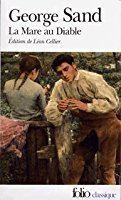Originally published 1846 | ||
 | ||
Similar George Sand books, Classical Studies books | ||
La Mare au Diable (The Devil's Pool) is an 1846 novel by George Sand.
Contents
- la mare au diable de george sand alchimie d un roman pisode n 38
- Background
- Plot
- Reception and legacy
- Criticism
- Translations
- References
la mare au diable de george sand alchimie d un roman pisode n 38
Background
The novel is first in a series of four pastoral novels by Sand, based on her childhood; it was followed by François le Champi (1847–1848), La Petite Fadette (1849), and Les Beaux Messieurs Bois-Doré (1857).
Plot
The Pere Maurice is talking to Germain, his 28-year-old young son-in-law, about Germaine taking a new wife. Germain has been a widower for two years, and his wife left behind three young children. (Pere means Father but it means Old Man). Maurice wants Germain to go visit his friend, Pere Leonard, at a farm about half a day's ride away, to visit Leonard's daughter, a rich widow who is looking to remarry. Her name is Catherine Guerin and it appears she is a good person. Germain does not really want to remarry, but Maurice tells him that two years is long enough to be in mourning, that he is grateful for Germain having been good to his daughter, and that the children need a mother. He and his wife cannot continue to take care of the three young children, and his son and daughter-in-law are expecting a baby, so will not be able to help. Germain finally agrees. Maurice tells Germain to take the beautiful grey mare and a present of game to Leonard and the widow, and to leave Saturday, spend the night at the widow's farm, and come back on Sunday.
Reception and legacy
The novel (specifically, its opening scene) is supposed to have been the inspiration for Rosa Bonheur's 1849 painting Ploughing in the Nivernais.
Criticism
A contrasexual, queer reading of the novel was offered by James Hamilton, who suggested that, rather than see Germain as a projection of a male author, Marie could profitably be regarded as an ego-heroine; according to Hamilton, such a reading offers a better explanation of the title (and its explicit reference to a female element, water) and greater depth for Marie's two suitors.
Translations
The novel has been translated into English seven times between 1847 and 2005, more than any other Sand novel.
